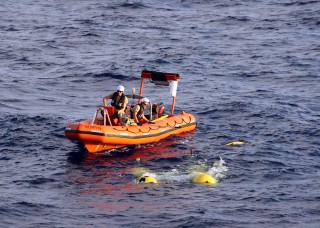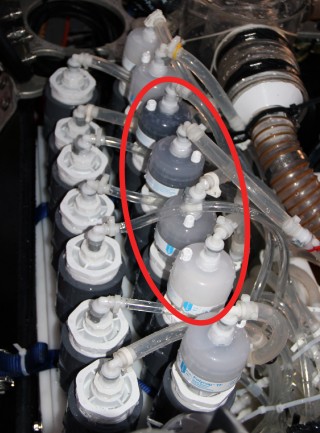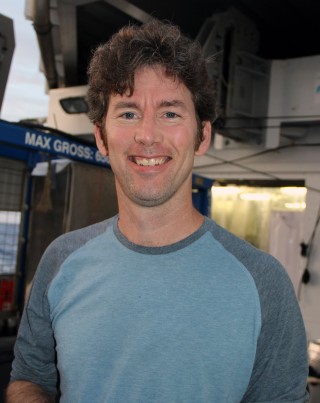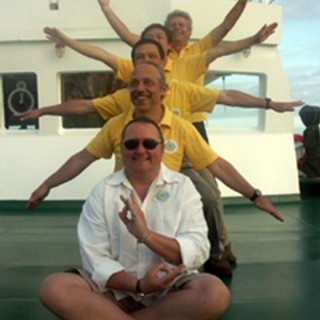Science seriously progressed today.
It didn’t come easy but maybe that just makes it all the sweeter.

Our launch was text-book just after 4am and separation went well at 5:30am with only a few moments of tension as we passed through 2000m. Then, right on schedule, at 7:30am we made “landfall” at just less than 5000m. Then came the most taxing 4 hours or so of the cruise, thus far, for me. Despite having relived every moment of our Piccard Hydrothermal Field dives at least 3 times in the past 18 months (many a happy hour reviewing DVDs and HD video in my basement), I really struggled to work out where we were from the views of the seafloor provided from the James Cameron camera.
In parallel, James was having trouble confirming how we were doing with our navigation systems on this cruise and how they could be reconciled with our previous mapping efforts. And of course, just when you need a little luck, ours deserted us. So we managed to head upslope from where we arrived at the seafloor and, for the want of a 20m error, managed to slip between the two hydrothermal mounds we had wanted to visit today and, instead, found ourselves over near the third site – where Ken Takai had broadcast from 2 days ago – and face to face with the umbilical cable that had been left behind by Shinkai, which was both longer and thicker than we had been prepared for: a veritable trip hazard for our delicate little vehicle.

Conferring fast with both James and Casey, who was piloting, we turned to right/starboard, fors parallel to and then peeling away from the cable as we curved round back to the north to go find the vent-site with the highest temperature black smokers that were today’s priority. All seemed to start going well except that as we felt we were on track and heading in the right direction we found a second Shinkai umbilical cord blocking our path strung between sulfide precipices. We had no choice but to turn again and head upslope paralleling the cord and making sure we didn’t get Nereus entangled.
All that collision avoidance got us rather disoriented and we spent the next hour or two still circling around trying to get to where we knew the vents should be but, repeatedly, encountering the same yellow cables stretched out across our path. Eventually, Casey agreed with me that the only way to get to the vents was to find a spot where we could safely get Nereus and its fibre optic cable safely up and over the significantly thicker yellow cables snaking across the seafloor. Thankfully that worked and our system survived.

Finally, at 10am, we arrived at the Beebe Vents black smokers that we had sampled extensively in 2012. Success I thought! Not so fast. As we tried to approach the vents, Nereuswas swept up into the water column spun around some and when we got back to the seafloor we had to start our searching all over again. An hour later we were back at the vent-site and ready to go again, with Casey picking up the first of Jeff’s fluid samplers. After another 30 minutes we had been swept up in the water column again, put back down and by 11:45am we were back ready to sample vents again – but no matter how we tried we couldn’t get at the vent that we had initially hoped to sample.
Happily there are 5 separate vents at the Beebe Vents site that we could choose from so, eventually, as 1pm rolled around, we switched our attention to Beebe Vent #4 and sampled that instead. The first of our two high-Temperature samples was already pretty good but the second was awesome – a rock-solid 398°C fluid that made it, by 1°C, the hottest vent-fluid Jeff’s samplers have yet collected from this site; indeed, maybe the hottest vents Jeff has ever sampled? I should check on that. But maybe I don’t need to: I just read Jill’s entry in our Science Event Log: “awesome awesome awesome.” Happy student ☺ = Objective 1 for today’s dive completed.
Next up? Happy Texan time…
At 1:32pm, 6 hours after we arrived on the seafloor, we were ready to start our 2nd science priority of the day: helping Chip Breier carry out a really great sampling study of the buoyant plume material rising above the vents that Jeff, Jill & Sean had just sampled. First, using the temperature sensor that is mounted at the inlet of Chip’s “SUPR” sampler we collected background samples and also samples from just above the vents and again at 1m above the orifice.
Then, with Casey piloting still (he wouldn’t budge from the chair, all day) we flew Nereus up to first 5m and then 10m above the vent-site to collect the samples that Chip and his colleagues will use to investigate the processes that arise as the fluids emitted from the vents mix, turbulently, with the surrounding ocean: the processes that dictate what the impact is of hydrothermal venting on the ocean. As a topic dear to my heart, it was a particular personal pleasure to work with Chip on this aspect of the dive today and, because he is such a really good guy, to see it all come together so beautifully.
All too soon, Chip’s sampling was at an end. We had 30 minutes left to play and less than 5% battery power to spare so we dived back to the seafloor with ambitions to either (a) collect some sulfide minerals or (b) get back to the same black smokers and get Chip one more set of samples or (c) collect shrimp (our original 3rd priority for today’s dive). Soonest to occur was that we found a crevice packed with shrimp squirming in among some warm diffuse-flow venting: decision made – we stopped in our tracks, put Chip’s sampler away, picked up the nozzle for the Slurp sampler and sucked up about 100 shrimp from the deep site that will match the 100 specimens that we collected for Max and Cindy at the Von Damm site last Friday.
Somewhere along the way we also collected some really cool video and by 8pm we had Nereus back on deck, stuffed with samples, and plenty for our science team to go to work on. While they got to work on the new samples, Nathan and I arranged a background CTD station for Julie & Julie during which time, Chris Taylor (Good Chris) had the time to calculate that we will be good to go with enough electrons stuffed into our batteries to dive again at 4am tomorrow.
So: time to sleep fast!!! With that – goodnight!
Belay that ending – Casey just confirmed that although the batteries are good to go, other parts of Nereus are not: launching at 06h00 tomorrow instead.

